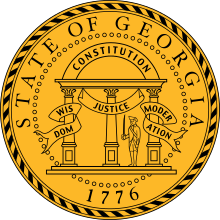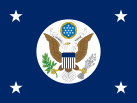John Forsyth (Georgia)
| John Forsyth |
|---|
 |
|
| 13th United States Secretary of State |
|---|
In office
July 1, 1834 – March 3, 1841 |
| President |
Andrew Jackson
Martin Van Buren |
|---|
| Preceded by |
Louis McLane |
|---|
| Succeeded by |
Daniel Webster |
|---|
| 33rd Governor of Georgia |
|---|
In office
November 7, 1827 – November 4, 1829 |
| Preceded by |
George M. Troup |
|---|
| Succeeded by |
George R. Gilmer |
|---|
Member of the U.S. House of Representatives
from Georgia's at-large district |
|---|
In office
March 4, 1813 – November 23, 1818 |
| Preceded by |
New appointment |
|---|
| Succeeded by |
Robert R. Reid |
|---|
In office
March 4, 1823 – March 3, 1827 |
| Preceded by |
Robert R. Reid |
|---|
| Succeeded by |
converted to districts |
|---|
United States Senator
from Georgia |
|---|
In office
November 23, 1818 – February 17, 1819 |
| Preceded by |
George Troup |
|---|
| Succeeded by |
Freeman Walker |
|---|
In office
November 9, 1829 – June 27, 1834 |
| Preceded by |
John M. Berrien |
|---|
| Succeeded by |
Alfred Cuthbert |
|---|
| Personal details |
|---|
| Born |
(1780-10-22)October 22, 1780
Fredericksburg, Virginia, U.S. |
|---|
| Died |
October 21, 1841(1841-10-21) (aged 60)
Washington D.C., U.S. |
|---|
| Political party |
Democratic |
|---|
| Spouse(s) |
Clara Meigs Forsyth |
|---|
| Alma mater |
College of New Jersey |
|---|
| Profession |
Politician, Lawyer |
|---|
John Forsyth, Sr. (October 22, 1780 – October 21, 1841) was a 19th-century American politician from Georgia.
Biography
Forsyth was born in Fredericksburg, Virginia. His father Robert Forsyth was the first U.S. Marshal to be killed in the line of duty in 1794. He was an attorney who graduated from the College of New Jersey (now Princeton University) in 1799. He married Clara Meigs, daughter of Josiah Meigs, in 1801 or 1802. One of his sons, John Forsyth, Jr., later became a newspaper editor. He served in the United States House of Representatives (1813–1818 and 1823–1827), the United States Senate (1818–1819 and 1829–1834), and as the 33rd Governor of Georgia (1827–1829). He was the United States Secretary of State from 1834 until 1841. In this role he led the government's response to the Amistad case. He was a loyal follower of Andrew Jackson and opposed John C. Calhoun in the issue of nullification. Forsyth was appointed as Secretary of State in reward for his efforts. Led the pro-removal reply to Theodore Frelinghuysen about the Indian Removal Act of 1830. He supported slavery and was a slaveholder himself. He died in Washington, D.C., and was buried in Congressional Cemetery. Forsyth County, Georgia is named for him.[1] He died the day before his 61st birthday.
In popular culture
Notes
References
External links
| United States House of Representatives |
Preceded by
New seat from congressional apportionment |
Member of the U.S. House of Representatives
from Georgia's at-large congressional district
March 4, 1813 – November 23, 1818 |
Succeeded by
Robert R. Reid |
Preceded by
Robert R. Reid |
Member of the U.S. House of Representatives
from Georgia's at-large congressional district
March 4, 1823 – March 3, 1827 |
Succeeded by
Converted to districts |
Preceded by
Redistricted from At Large District |
Member of the U.S. House of Representatives
from Georgia's 2nd congressional district
March 4, 1827 – November 7, 1827 |
Succeeded by
Richard Henry Wilde |
| United States Senate |
|
Preceded by
George Troup |
U.S. Senator (Class 2) from Georgia
November 23, 1818 – February 17, 1819
Served alongside: Charles Tait |
Succeeded by
Freeman Walker |
|
Preceded by
John M. Berrien |
U.S. Senator (Class 3) from Georgia
November 9, 1829 – June 27, 1834
Served alongside: George Troup and John P. King |
Succeeded by
Alfred Cuthbert |
| Diplomatic posts
|
|
Preceded by
George W. Erving |
United States Minister to Spain
May 18, 1819 – March 2, 1823 |
Succeeded by
Hugh Nelson |
| Political offices
|
|
Preceded by
George Troup |
Governor of Georgia
1827–1829 |
Succeeded by
George R. Gilmer |
|
Preceded by
Louis McLane |
U.S. Secretary of State
Served under: Andrew Jackson, Martin Van Buren
July 1, 1834 – March 3, 1841 |
Succeeded by
Daniel Webster |
|
|---|
| Council Presidents
(1775–76) | | |
|---|
| Presidents
(1776–77) | |
|---|
| Governors
(since 1777) | |
|---|
|
|
|---|
| Commerce and Manufactures
(1816–1825) | | |
|---|
| Commerce
(1825–1947) | |
|---|
| Interstate Commerce
(1887–1947) | |
|---|
| Interstate and Foreign Commerce/Commerce
(1947–1977) | |
|---|
| Commerce, Science, and Transportation
(1977–) | |
|---|
|

 This article incorporates public domain material from websites or documents of the Biographical Directory of the United States Congress.
This article incorporates public domain material from websites or documents of the Biographical Directory of the United States Congress.

